
One of the most talked-about dogs on the internet! The Pug is loved for their comical temperament, cute appearance and loyal nature.
The Pug is gentle and sociable, making them perfect for families (1).
They are devoted companions and you really couldn’t want a more charming temperament.
In recent years registrations of Pugs has rocketed, putting a huge demand on breeders and creating a welfare crisis for this dog breed.
For a number of years, vets have urged potential pet-parents to carefully consider this breed and to ensure they only adopt them from responsible breeders.
Their wrinkly short-muzzled face is iconic in the dog world. However, with it comes lots of health complications and careful exercise constraints – keep on reading to discover 12 facts about this breed.
TABLE OF CONTENTS
History Of The Pug Dog
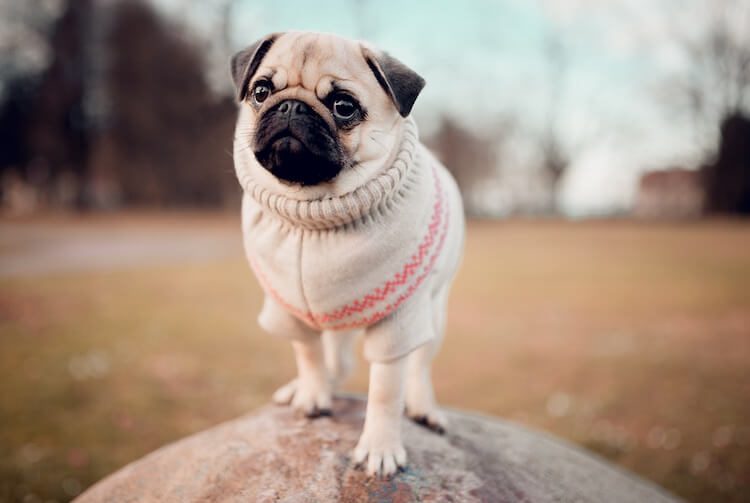
Originating in China, Pugs were bred to be companions for ruling families.
Highly valued by Emperors, these dogs lived a life of luxury and were even protected by soldiers (2). Making it to other parts of Asia, they were soon found in Buddhist monasteries too.
The Pug ranks a whopping 28 out of 195 as one of the most popular breeds in America; ranked by the American Kennel Club.
These dogs have been adored over centuries for devotion and loyalty to their owners. However, paintings in the 18th and 19th centuries depict the Pug with longer legs and snouts than the dog we see today.
It is possible that they would have experienced much fewer health issues than our modern-day Pug.
Through overbreeding and selectively breeding excessively flat-faced Pugs; the demand for designer dogs has created this welfare problem.
Which Kennel Clubs Recognize The Pug?
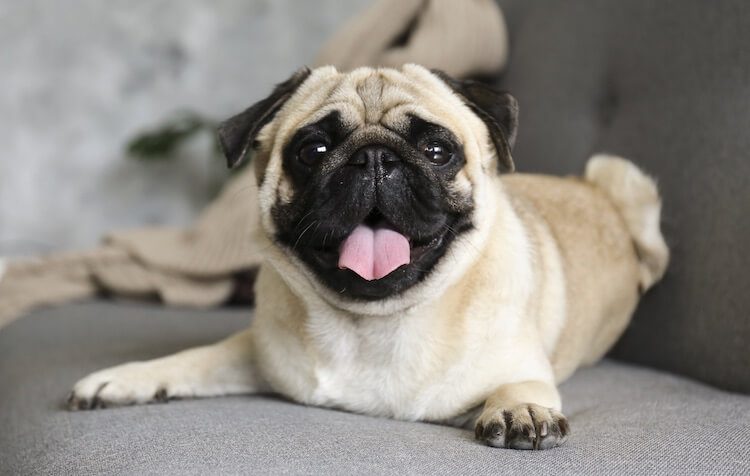
Being a purebred dog breed, they are recognized by every major kennel club world over (3). They are registered with:
- American Kennel Club
- Canadian Kennel Club
- UK Kennel Club
- United Kennel Club
- World Canine Organization
They are companion dogs classified in the Toy Group classification.
The Pug also has an official dog club that is responsible for sustaining the health and welfare of this breed.
| Size | 10 to 13 inches |
| Weight | 13 to 18 pounds |
| Lifespan | 13-15 years |
| Breed Type | Toy Group |
| Purpose | Companion |
| Suitable For | All Families |
| Color Variations | Fawn or Black |
| Temperament | Even-tempered, Stable, Playful, Charming and Loving |
Pug Temperament

Pug dogs are friendly, playful and their small size also makes them great pets for smaller homes and younger families.It is very easy to see why the Pug is so popular.
They are stable and predictable, but also have a stubborn streak. This stubborn streak makes training a little more of a challenge.
So, if you like a dog with a little character and sass, the Pug is perfect for you!
Being a loyal companion, this dog doesn’t tolerate being left alone for long periods of time.
Separation anxiety can be an issue. If this does become a problem for you, seek the advice of a qualified behaviorist in your area, and don’t leave him alone until you can address it.
Is A Pug A Good Family Dog?
| Family Member | Compatible |
| Young Children | Yes |
| Teenagers | Yes |
| Seniors | Yes |
| Other Pets | Yes |
Yes! The Pug adores humans of all shapes and sizes (4) and are great companions for kids, perfect for singles and the ideal lap dog for seniors.
Pugs are also pretty tolerant of other pets in the house, both small furries and other dogs.
They are adaptable, so when raised with other animals, they cope fine in multi-pet homes. They will quickly settle into a busy home.
Potential owners tend to think this breed is lower in exercise requirements, which unfortunately is correct. This is down to the fact that they struggle to breathe so they are unable to exercise as much as other dogs.
Taking Care of Your Pug Dog

We have established that the Pug has a perfect personality to fit in with most families and living environments (5).
They are a small enough dog to suit apartment living, friendly enough to live in multi-pet homes and stable enough for families with smaller kids or seniors.
Despite this, when you bring a Pug into to your life, you are not in for an easy ride.
They are prone to obesity, often have trouble breathing, and frequently require surgery to help them lead a normal life.
While the Pug looks irresistibly cute, and they have an awesome temperament, most do not lead normal lives because of their associate health issues (more on this below).
How Much Should You Feed A Pug
| Daily Food Consumption | |
|---|---|
| Guide | ~500 calories |
| Cups of Kibble | |
Due to the restrictions around exercising a Pug, they often become overweight – this doesn’t help when they are already struggling to breathe.
For that reason, portion control is of utmost importance if you own this breed.
Avoid allowing your Pug to graze throughout the day on snacks and tidbits (6). Make sure you stick to a routine for mealtimes as you are then more likely to stick to the amount of food he needs.
Excess treats should be limited, so if you are training, then some of their daily meal-allowance should be swapped out for their treat allowance.
Retching and regurgitating is common in Pugs due to the excess tissue being present in areas in the throat, so this can be more common around feeding times. It’s usually nothing to worry about, but it’s worth being aware of, just in case it happens.
Feed a high-quality food, with good protein and fat content.
How Much Exercise Do Pugs Need?
| Daily Exercise Requirements | |
|---|---|
| Minutes | 30 minutes |
| Activity Level | |
| Favorite Exercise | Swimming |
If your Pug is particularly flat-faced, and has issues breathing, then exercise becomes problematic from a very young age.
Because of a lack of exercise, this also leads to an increased likelihood of obesity and related health issues.
It is possible to focus on more mental stimulation to keep your Pug occupied, but exercise is a key component of optimal dog health.
Short, frequent walks are the only option for any parent. You should aim to walk your Pug for 2 x 15 minutes each day (morning and evening) (7).
Thanks to their stubborn streak, it’s probably best keeping them on leash too! Recall can be a challenge for these friendly guys.
To enable an improved quality of life, some Pugs undergo corrective airway surgery to help them breathe better. As always, its best to speak with your vet if you are concerned about exercising your dog.
How To Train Pugs
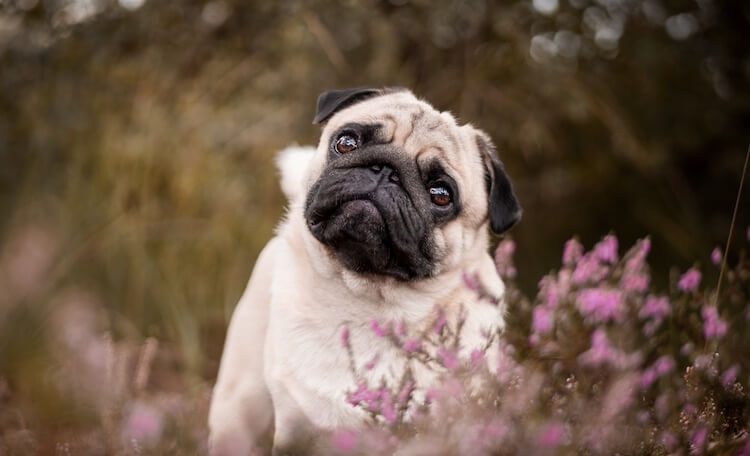
Speaking of walking your dog this breed can be stubborn, but they are generally well-meaning and devoted to their owner.
Being friendly and playful, they can be quite sensitive too, so don’t cope very well with harsh training methods (nor do any other dog breeds!)
Positive reinforcement training (8) is the best technique to use with these guys. Just make sure you monitor the treat allowance due to their predisposition to gaining weight.
This breed loves to learn new tricks, and if exercise is limited, this can be a great way to keep them stimulated.
How To Groom A Pug Dog
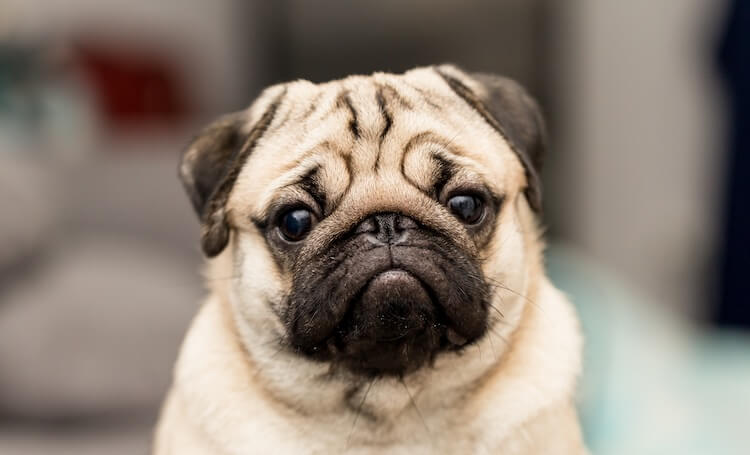
Brushing twice or three-times a week with a rubber bristled tool will be enough to keep their coat in great condition (9)!
If your dog is restricted from exercise, keep an eye on their nails as they may become too long. You will need to trim them when necessary because they won’t be benefitting from hard outdoor surfaces (e.g. pavements) naturally wearing them down.
Due to their wrinkly appearance, many Pugs suffer with skin issues as bacteria sits in the wrinkles and skin folds. This can be managed well by frequent bathing, but again this must be monitored.
Make sure you keep their teeth clean too. Their short muzzle can restrict their chewing efforts which will ultimately affect tooth health.
Like all toy dog breeds, they are prone to overcrowding in their mouth, so keep an eye on this during puppyhood.
Known Health Issues

Whilst there is no denying some breeders, associations, and clubs are trying their best to improve the health of this breed, vets are still worried about the future of this breed.
The most obvious health issue is that the Pug struggles to breath (10).
All major dog shows have stipulated that judges should not award prizes for dogs who cannot breathe sufficiently.
When combined with a continued effort of all involved with this breed, will guide future breeding in the hope to better the overall health and well-being of the breed.
As their eyes protrude (i.e. stick out somewhat), the Pug dog is prone to a range of eye conditions and infections:
- Corneal ulcers
- Cataracts
- Entropion
- Cherry eye
By now, you should be aware of a Pug’s difficulty breathing, but this can become a huge issue throughout your dog’s life.
Dogs pant to regulate their body temperature (they don’t sweat like humans).
If they are unable to pant effectively, they are more prone to suffer heat stroke which can be fatal.
Many owners think the brachy snore is endearing, but sadly it is because they are struggling to get oxygen into their body. Finally, their tongues are often too big for their head, which causes further obstructions.
Brachycephalic breeds draw harder when they breathe in to compensate for their breathing difficulties. Unfortunately, this results in a negative pressure in their neck, chest and throat, often leading to further respiratory diseases.
When you have a dog who struggles to exercise, they are more likely to gain weight. You then have the health issues associated with obesity and breathing difficulties to contend with.
Unfortunately, all of these health problems and complications make a Pug one of the unhealthiest dog breeds known to man.
Breed Appearance: Size, Color and Coat
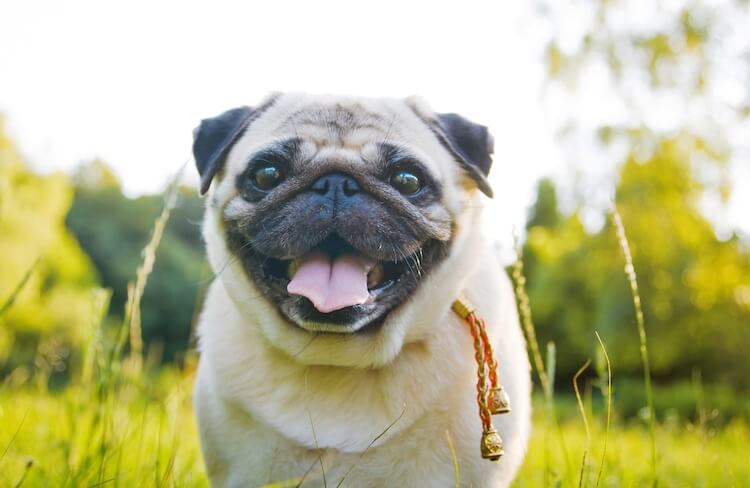
How Big Do Pugs Get?
The Pug will stand between 10 to 13 inches in height and weigh in around 13-18 pounds.
They are rightly placed in the toy-dog group classification by all kennel clubs.
This dog breed can come in either black or fawn and as a puppy you will immediately notice their flat, wrinkly face, usually followed by hearing their snorts.
Coat and Colors
They have a short, smooth coat which comes in pretty low on grooming maintenance. You just have to keep those wrinkles clean to prevent infections.
The fawn Pug tends to have a black mask, but the black variety such as the Black Pug is normally black all over, both colors have a tight curly tail!
Pug Puppy
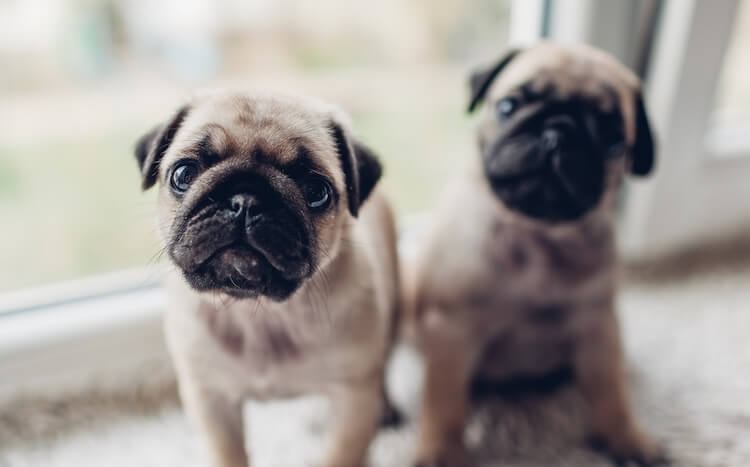
As the Pug is classed as a toy breed, litters are usually small. You won’t usually expect any more than four puppies per litter, and some are as small as just two.
Your puppy will be tiny, they are in the Toy Group for a reason!
At birth he will be around 2-4 pounds. At 6 months, he will be between 7 and 12 pounds. He’ll be fully grown at around 12 months weighing anywhere between 13-18 pounds:
| Age (months | Weight (lb) |
| 0 | 2 to 4 |
| 6 | 7 to 12 |
| 12 | 13 to 18 |
How Much Do Pug Puppies Cost?
Depending on their history, pedigree and location, these puppies will vary from between $600-$2,000 USD (11).
You should insure your puppy as soon as possible as their potential lifelong vet fees could be far in excess of their adoption price!
Where To Adopt
Just like any breed, Pugs find themselves in shelters too (for a range of reasons). Thankfully there are many dedicated rescue organizations!
Summary
The Pug is friendly and playful dog.
They are a devoted companion and you couldn’t wish for a better temperament.
Over-breeding, due to celebrity endorsement and movies, has resulted in high numbers having awful health conditions (12).
Some incredible breeders are working hard to bring the Pug back to life, but this takes time.
They are an ideal companion for families of all shapes and sizes (with kids, without kids, singles and seniors).
In good health, they are relatively low on care needs, they don’t eat much, and don’t need hours and hours of exercise – they are just happy being with you!
Ultimately, if you choose to bring a Pug into your home, select him for good health (not appearance). Or you can choose a similar breed with a much better health record (e.g. coton de Tulear).

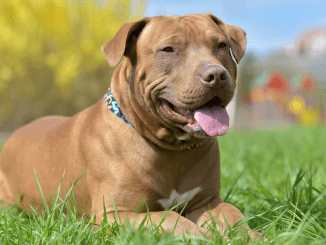
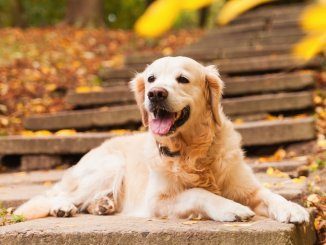
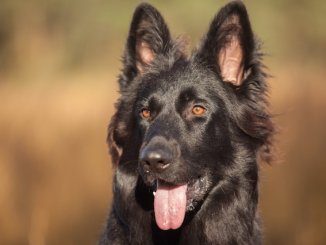
We had a pug (Edison) for 17 years. Adored him as did all of family and friends. They are such a great family dog and as do all pets, deserves to have a home that really tends to them. You didn’t say anything about shedding. They do tend to shed. We miss our Edison terribly as he passed away 8 months ago. Your description of the pug was spot on. Thanks